BTEC Education: Teaching, Learning and Assessment in Business
VerifiedAdded on 2022/11/13
|29
|6107
|491
Report
AI Summary
This report, prepared for a BTEC Diploma in Education and Training, examines the multifaceted role of a business management lecturer, emphasizing curriculum design, effective teaching methods, and student assessment. The report highlights the importance of understanding diverse student needs, creating flexible curricula, and balancing professional responsibilities within an educational institution. It details strategies for assessing student comprehension, including the use of regular assessments and providing additional support. The report includes a scheme of work, teaching and learning plans, and discusses activities that promote inclusivity by accommodating various learning styles and addressing social, economic, and individual differences among students. Feedback mechanisms are proposed to gauge the effectiveness of inclusive practices. This assignment, contributed by a student to Desklib, offers valuable insights into creating a supportive and effective learning environment.
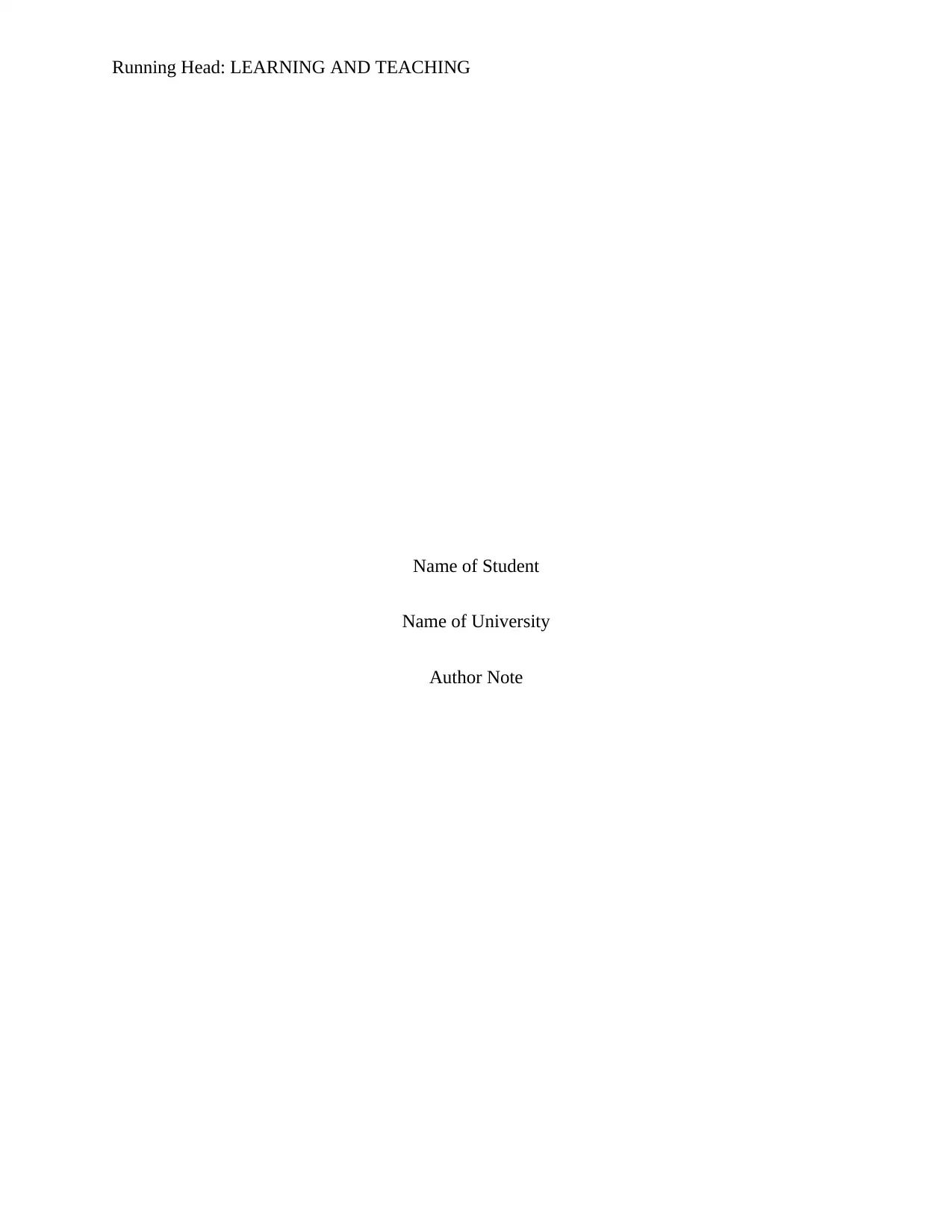
Running Head: LEARNING AND TEACHING
Name of Student
Name of University
Author Note
Name of Student
Name of University
Author Note
Paraphrase This Document
Need a fresh take? Get an instant paraphrase of this document with our AI Paraphraser
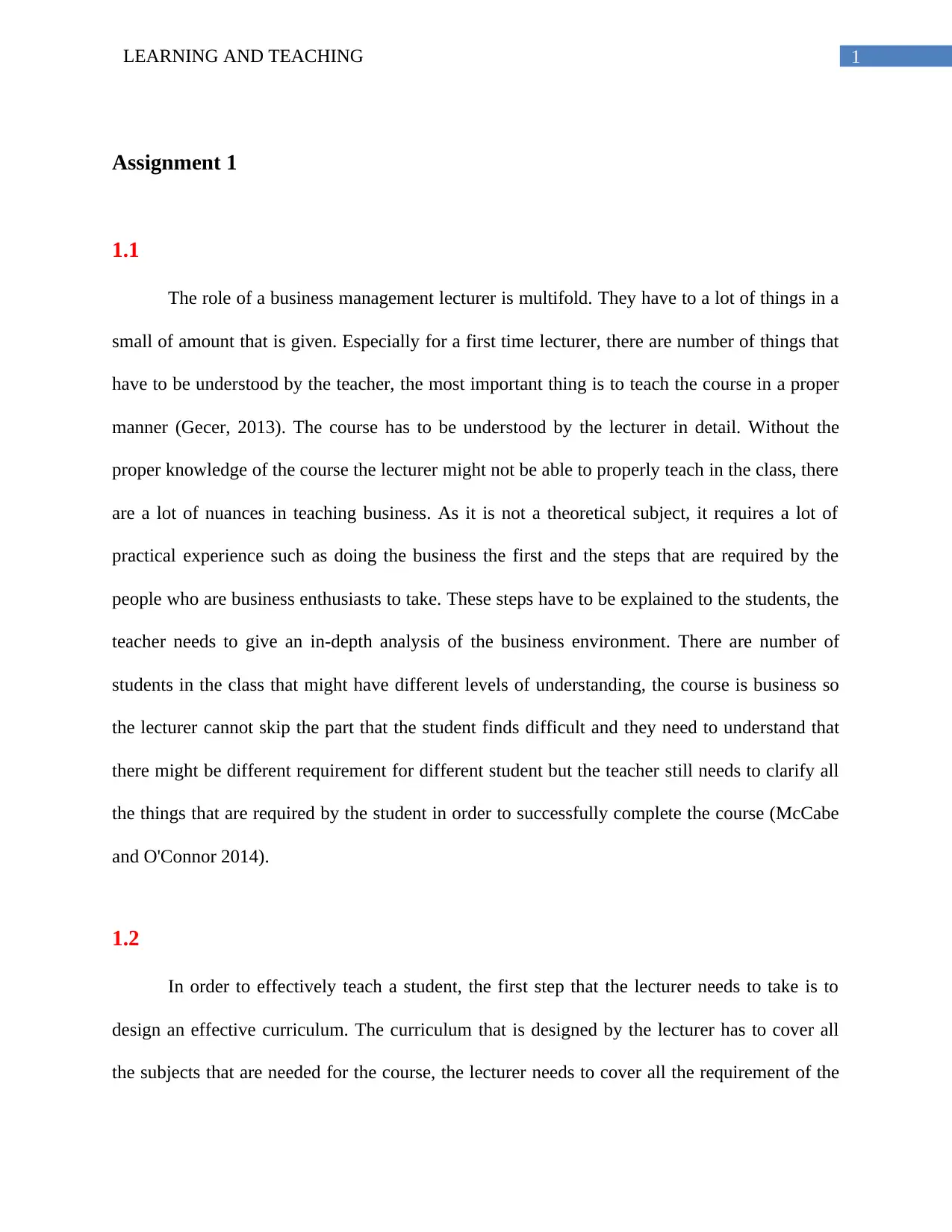
1LEARNING AND TEACHING
Assignment 1
1.1
The role of a business management lecturer is multifold. They have to a lot of things in a
small of amount that is given. Especially for a first time lecturer, there are number of things that
have to be understood by the teacher, the most important thing is to teach the course in a proper
manner (Gecer, 2013). The course has to be understood by the lecturer in detail. Without the
proper knowledge of the course the lecturer might not be able to properly teach in the class, there
are a lot of nuances in teaching business. As it is not a theoretical subject, it requires a lot of
practical experience such as doing the business the first and the steps that are required by the
people who are business enthusiasts to take. These steps have to be explained to the students, the
teacher needs to give an in-depth analysis of the business environment. There are number of
students in the class that might have different levels of understanding, the course is business so
the lecturer cannot skip the part that the student finds difficult and they need to understand that
there might be different requirement for different student but the teacher still needs to clarify all
the things that are required by the student in order to successfully complete the course (McCabe
and O'Connor 2014).
1.2
In order to effectively teach a student, the first step that the lecturer needs to take is to
design an effective curriculum. The curriculum that is designed by the lecturer has to cover all
the subjects that are needed for the course, the lecturer needs to cover all the requirement of the
Assignment 1
1.1
The role of a business management lecturer is multifold. They have to a lot of things in a
small of amount that is given. Especially for a first time lecturer, there are number of things that
have to be understood by the teacher, the most important thing is to teach the course in a proper
manner (Gecer, 2013). The course has to be understood by the lecturer in detail. Without the
proper knowledge of the course the lecturer might not be able to properly teach in the class, there
are a lot of nuances in teaching business. As it is not a theoretical subject, it requires a lot of
practical experience such as doing the business the first and the steps that are required by the
people who are business enthusiasts to take. These steps have to be explained to the students, the
teacher needs to give an in-depth analysis of the business environment. There are number of
students in the class that might have different levels of understanding, the course is business so
the lecturer cannot skip the part that the student finds difficult and they need to understand that
there might be different requirement for different student but the teacher still needs to clarify all
the things that are required by the student in order to successfully complete the course (McCabe
and O'Connor 2014).
1.2
In order to effectively teach a student, the first step that the lecturer needs to take is to
design an effective curriculum. The curriculum that is designed by the lecturer has to cover all
the subjects that are needed for the course, the lecturer needs to cover all the requirement of the
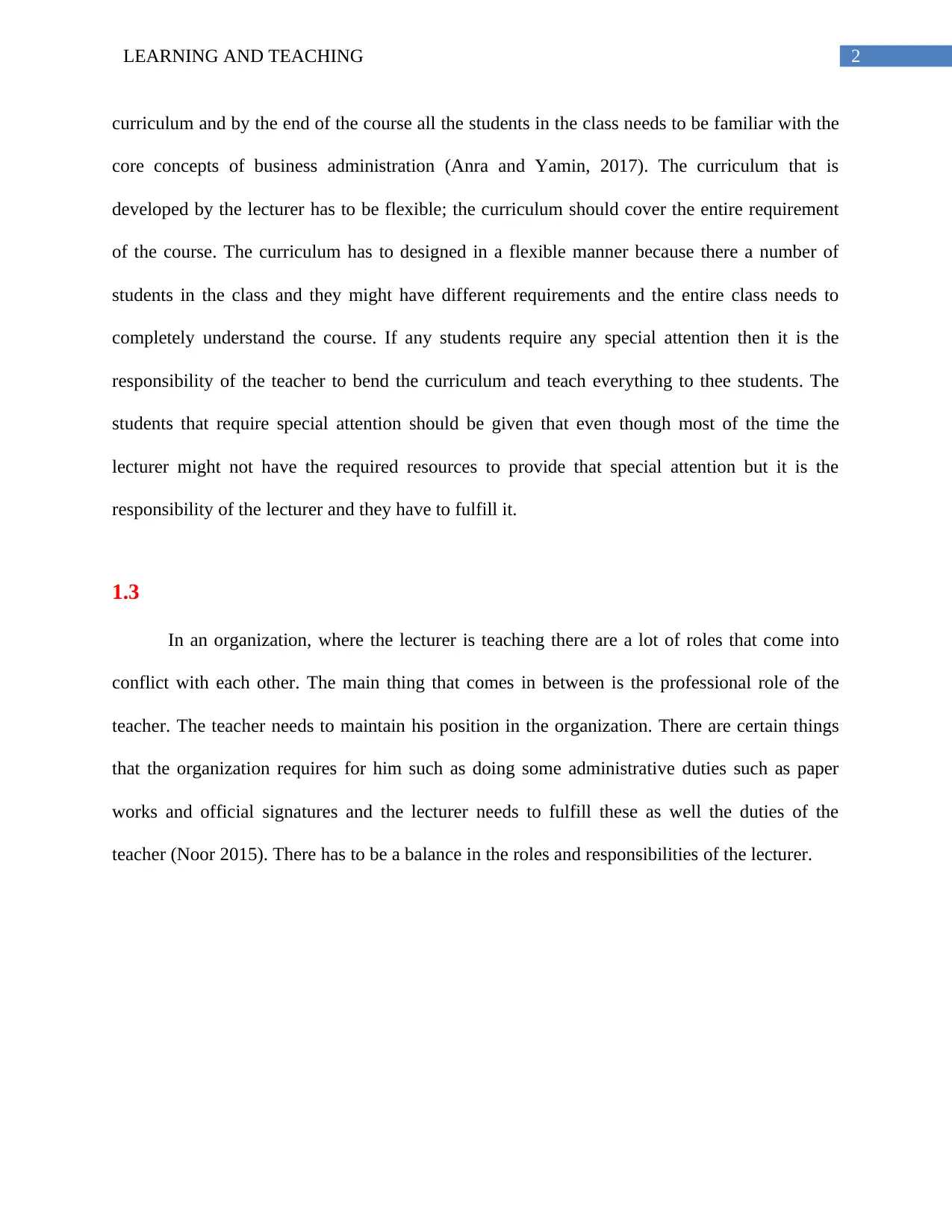
2LEARNING AND TEACHING
curriculum and by the end of the course all the students in the class needs to be familiar with the
core concepts of business administration (Anra and Yamin, 2017). The curriculum that is
developed by the lecturer has to be flexible; the curriculum should cover the entire requirement
of the course. The curriculum has to designed in a flexible manner because there a number of
students in the class and they might have different requirements and the entire class needs to
completely understand the course. If any students require any special attention then it is the
responsibility of the teacher to bend the curriculum and teach everything to thee students. The
students that require special attention should be given that even though most of the time the
lecturer might not have the required resources to provide that special attention but it is the
responsibility of the lecturer and they have to fulfill it.
1.3
In an organization, where the lecturer is teaching there are a lot of roles that come into
conflict with each other. The main thing that comes in between is the professional role of the
teacher. The teacher needs to maintain his position in the organization. There are certain things
that the organization requires for him such as doing some administrative duties such as paper
works and official signatures and the lecturer needs to fulfill these as well the duties of the
teacher (Noor 2015). There has to be a balance in the roles and responsibilities of the lecturer.
curriculum and by the end of the course all the students in the class needs to be familiar with the
core concepts of business administration (Anra and Yamin, 2017). The curriculum that is
developed by the lecturer has to be flexible; the curriculum should cover the entire requirement
of the course. The curriculum has to designed in a flexible manner because there a number of
students in the class and they might have different requirements and the entire class needs to
completely understand the course. If any students require any special attention then it is the
responsibility of the teacher to bend the curriculum and teach everything to thee students. The
students that require special attention should be given that even though most of the time the
lecturer might not have the required resources to provide that special attention but it is the
responsibility of the lecturer and they have to fulfill it.
1.3
In an organization, where the lecturer is teaching there are a lot of roles that come into
conflict with each other. The main thing that comes in between is the professional role of the
teacher. The teacher needs to maintain his position in the organization. There are certain things
that the organization requires for him such as doing some administrative duties such as paper
works and official signatures and the lecturer needs to fulfill these as well the duties of the
teacher (Noor 2015). There has to be a balance in the roles and responsibilities of the lecturer.
⊘ This is a preview!⊘
Do you want full access?
Subscribe today to unlock all pages.

Trusted by 1+ million students worldwide
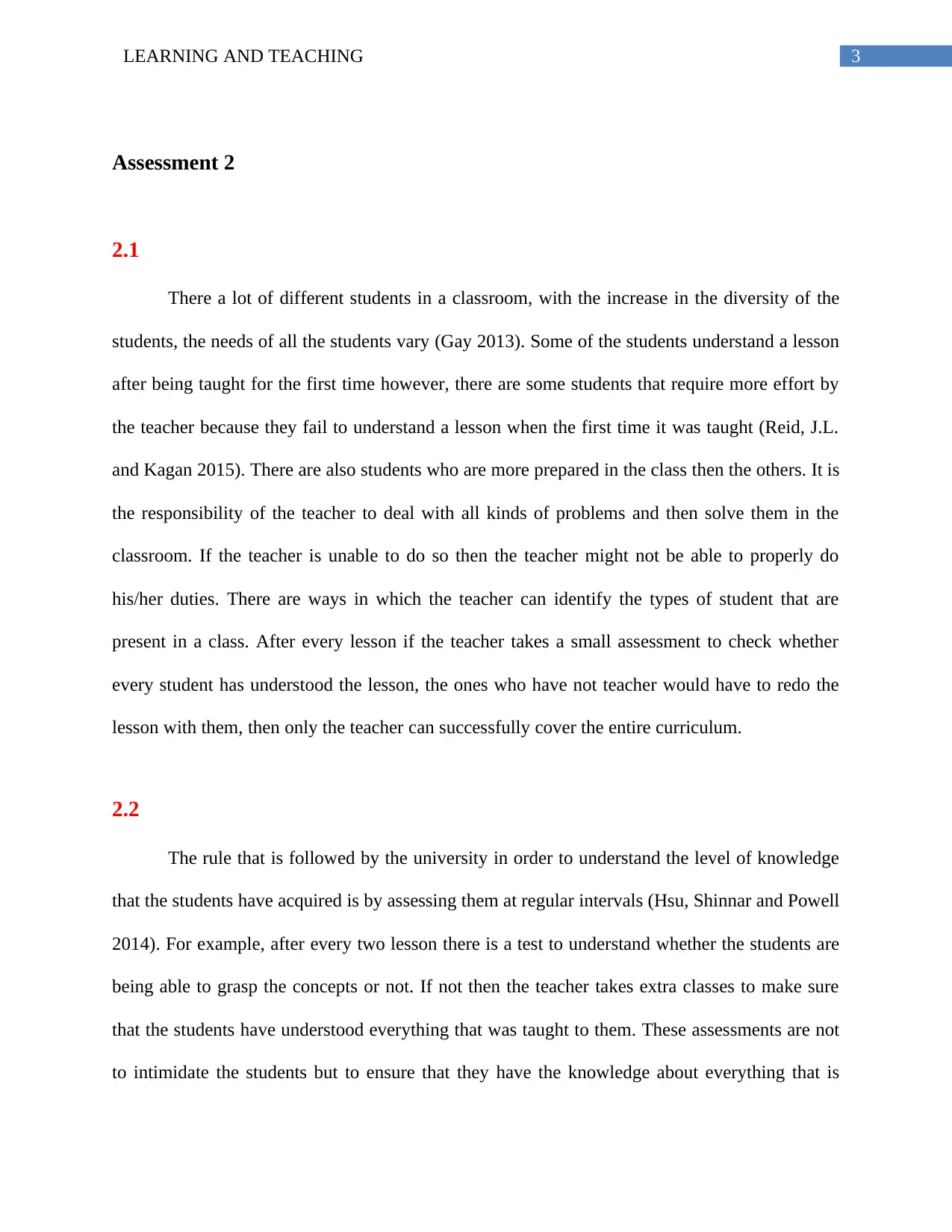
3LEARNING AND TEACHING
Assessment 2
2.1
There a lot of different students in a classroom, with the increase in the diversity of the
students, the needs of all the students vary (Gay 2013). Some of the students understand a lesson
after being taught for the first time however, there are some students that require more effort by
the teacher because they fail to understand a lesson when the first time it was taught (Reid, J.L.
and Kagan 2015). There are also students who are more prepared in the class then the others. It is
the responsibility of the teacher to deal with all kinds of problems and then solve them in the
classroom. If the teacher is unable to do so then the teacher might not be able to properly do
his/her duties. There are ways in which the teacher can identify the types of student that are
present in a class. After every lesson if the teacher takes a small assessment to check whether
every student has understood the lesson, the ones who have not teacher would have to redo the
lesson with them, then only the teacher can successfully cover the entire curriculum.
2.2
The rule that is followed by the university in order to understand the level of knowledge
that the students have acquired is by assessing them at regular intervals (Hsu, Shinnar and Powell
2014). For example, after every two lesson there is a test to understand whether the students are
being able to grasp the concepts or not. If not then the teacher takes extra classes to make sure
that the students have understood everything that was taught to them. These assessments are not
to intimidate the students but to ensure that they have the knowledge about everything that is
Assessment 2
2.1
There a lot of different students in a classroom, with the increase in the diversity of the
students, the needs of all the students vary (Gay 2013). Some of the students understand a lesson
after being taught for the first time however, there are some students that require more effort by
the teacher because they fail to understand a lesson when the first time it was taught (Reid, J.L.
and Kagan 2015). There are also students who are more prepared in the class then the others. It is
the responsibility of the teacher to deal with all kinds of problems and then solve them in the
classroom. If the teacher is unable to do so then the teacher might not be able to properly do
his/her duties. There are ways in which the teacher can identify the types of student that are
present in a class. After every lesson if the teacher takes a small assessment to check whether
every student has understood the lesson, the ones who have not teacher would have to redo the
lesson with them, then only the teacher can successfully cover the entire curriculum.
2.2
The rule that is followed by the university in order to understand the level of knowledge
that the students have acquired is by assessing them at regular intervals (Hsu, Shinnar and Powell
2014). For example, after every two lesson there is a test to understand whether the students are
being able to grasp the concepts or not. If not then the teacher takes extra classes to make sure
that the students have understood everything that was taught to them. These assessments are not
to intimidate the students but to ensure that they have the knowledge about everything that is
Paraphrase This Document
Need a fresh take? Get an instant paraphrase of this document with our AI Paraphraser
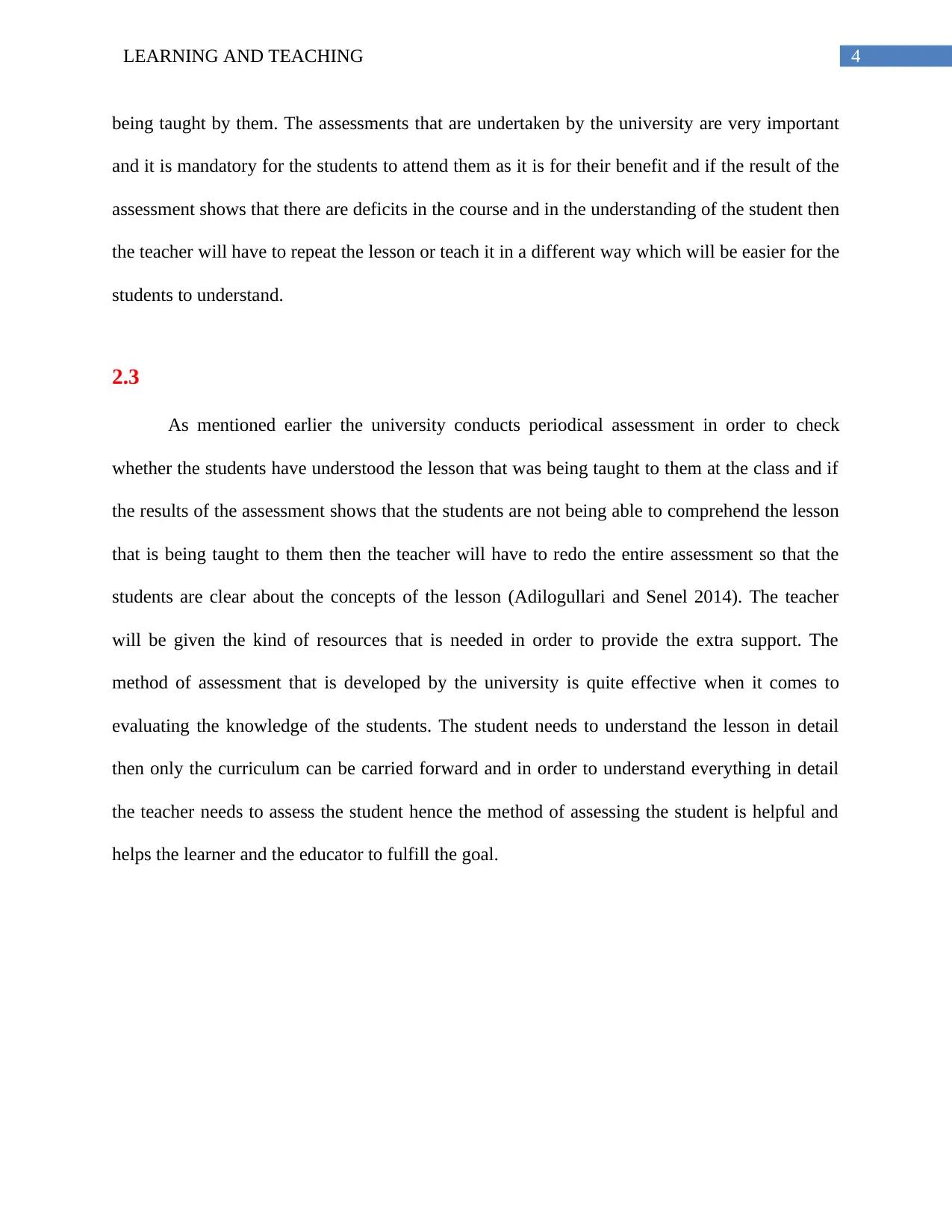
4LEARNING AND TEACHING
being taught by them. The assessments that are undertaken by the university are very important
and it is mandatory for the students to attend them as it is for their benefit and if the result of the
assessment shows that there are deficits in the course and in the understanding of the student then
the teacher will have to repeat the lesson or teach it in a different way which will be easier for the
students to understand.
2.3
As mentioned earlier the university conducts periodical assessment in order to check
whether the students have understood the lesson that was being taught to them at the class and if
the results of the assessment shows that the students are not being able to comprehend the lesson
that is being taught to them then the teacher will have to redo the entire assessment so that the
students are clear about the concepts of the lesson (Adilogullari and Senel 2014). The teacher
will be given the kind of resources that is needed in order to provide the extra support. The
method of assessment that is developed by the university is quite effective when it comes to
evaluating the knowledge of the students. The student needs to understand the lesson in detail
then only the curriculum can be carried forward and in order to understand everything in detail
the teacher needs to assess the student hence the method of assessing the student is helpful and
helps the learner and the educator to fulfill the goal.
being taught by them. The assessments that are undertaken by the university are very important
and it is mandatory for the students to attend them as it is for their benefit and if the result of the
assessment shows that there are deficits in the course and in the understanding of the student then
the teacher will have to repeat the lesson or teach it in a different way which will be easier for the
students to understand.
2.3
As mentioned earlier the university conducts periodical assessment in order to check
whether the students have understood the lesson that was being taught to them at the class and if
the results of the assessment shows that the students are not being able to comprehend the lesson
that is being taught to them then the teacher will have to redo the entire assessment so that the
students are clear about the concepts of the lesson (Adilogullari and Senel 2014). The teacher
will be given the kind of resources that is needed in order to provide the extra support. The
method of assessment that is developed by the university is quite effective when it comes to
evaluating the knowledge of the students. The student needs to understand the lesson in detail
then only the curriculum can be carried forward and in order to understand everything in detail
the teacher needs to assess the student hence the method of assessing the student is helpful and
helps the learner and the educator to fulfill the goal.
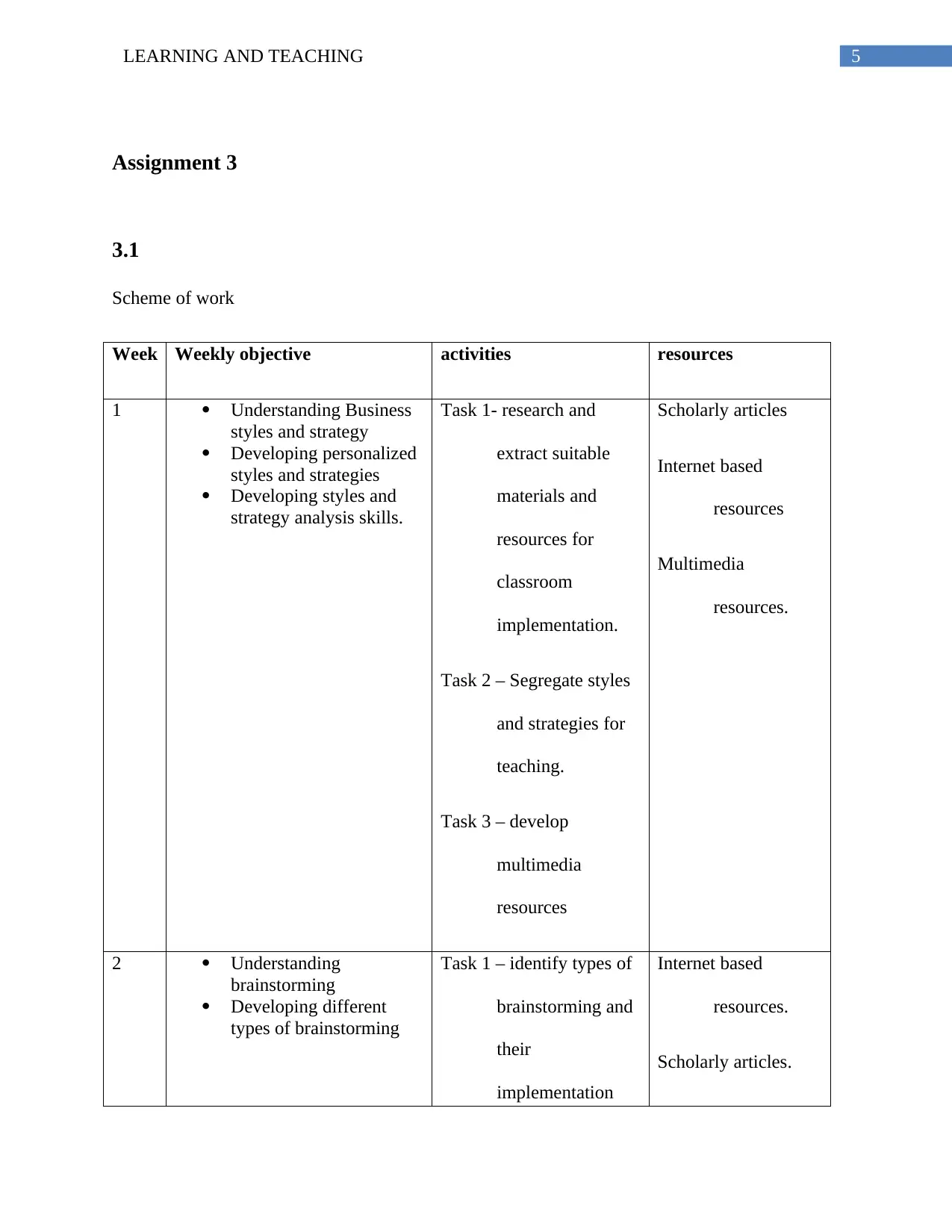
5LEARNING AND TEACHING
Assignment 3
3.1
Scheme of work
Week Weekly objective activities resources
1 Understanding Business
styles and strategy
Developing personalized
styles and strategies
Developing styles and
strategy analysis skills.
Task 1- research and
extract suitable
materials and
resources for
classroom
implementation.
Task 2 – Segregate styles
and strategies for
teaching.
Task 3 – develop
multimedia
resources
Scholarly articles
Internet based
resources
Multimedia
resources.
2 Understanding
brainstorming
Developing different
types of brainstorming
Task 1 – identify types of
brainstorming and
their
implementation
Internet based
resources.
Scholarly articles.
Assignment 3
3.1
Scheme of work
Week Weekly objective activities resources
1 Understanding Business
styles and strategy
Developing personalized
styles and strategies
Developing styles and
strategy analysis skills.
Task 1- research and
extract suitable
materials and
resources for
classroom
implementation.
Task 2 – Segregate styles
and strategies for
teaching.
Task 3 – develop
multimedia
resources
Scholarly articles
Internet based
resources
Multimedia
resources.
2 Understanding
brainstorming
Developing different
types of brainstorming
Task 1 – identify types of
brainstorming and
their
implementation
Internet based
resources.
Scholarly articles.
⊘ This is a preview!⊘
Do you want full access?
Subscribe today to unlock all pages.

Trusted by 1+ million students worldwide
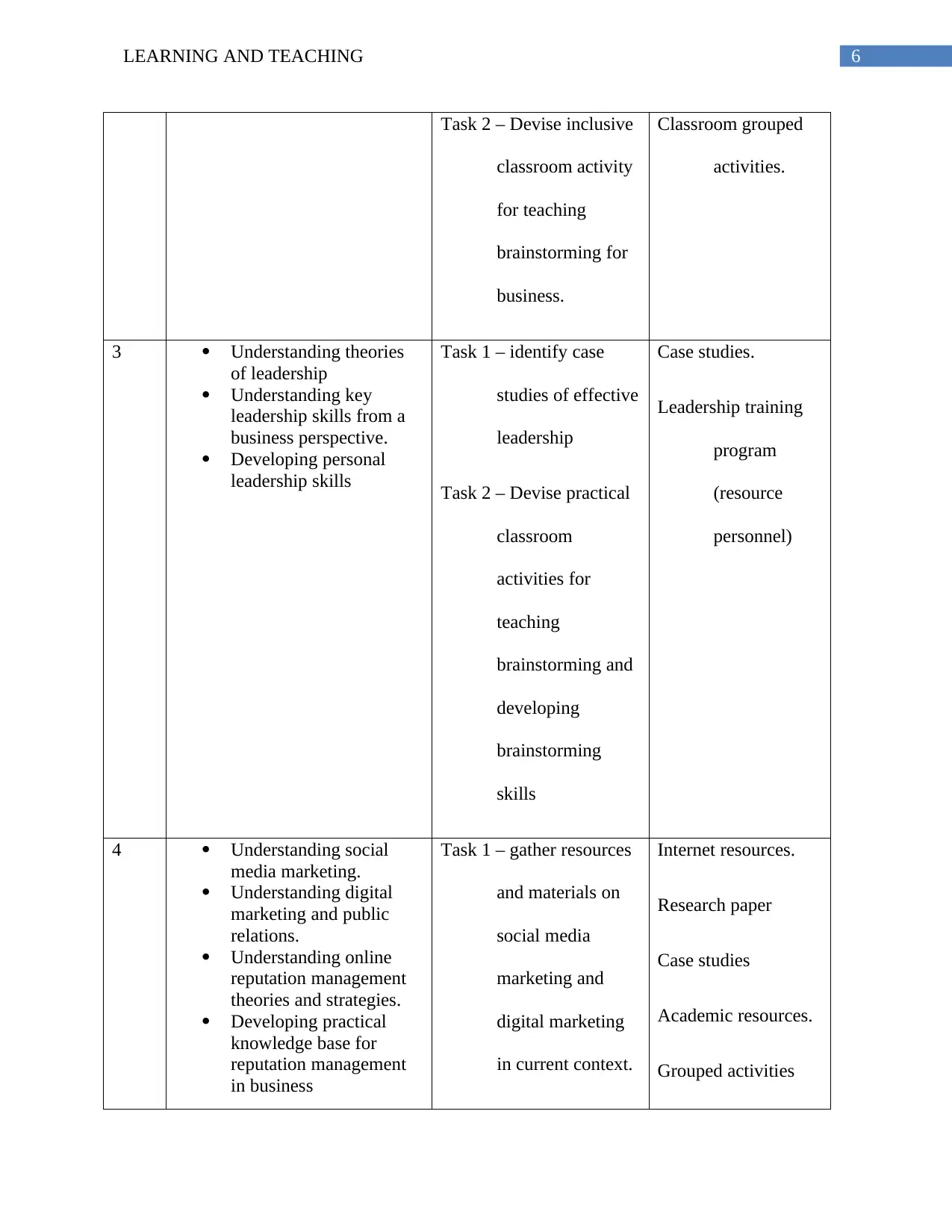
6LEARNING AND TEACHING
Task 2 – Devise inclusive
classroom activity
for teaching
brainstorming for
business.
Classroom grouped
activities.
3 Understanding theories
of leadership
Understanding key
leadership skills from a
business perspective.
Developing personal
leadership skills
Task 1 – identify case
studies of effective
leadership
Task 2 – Devise practical
classroom
activities for
teaching
brainstorming and
developing
brainstorming
skills
Case studies.
Leadership training
program
(resource
personnel)
4 Understanding social
media marketing.
Understanding digital
marketing and public
relations.
Understanding online
reputation management
theories and strategies.
Developing practical
knowledge base for
reputation management
in business
Task 1 – gather resources
and materials on
social media
marketing and
digital marketing
in current context.
Internet resources.
Research paper
Case studies
Academic resources.
Grouped activities
Task 2 – Devise inclusive
classroom activity
for teaching
brainstorming for
business.
Classroom grouped
activities.
3 Understanding theories
of leadership
Understanding key
leadership skills from a
business perspective.
Developing personal
leadership skills
Task 1 – identify case
studies of effective
leadership
Task 2 – Devise practical
classroom
activities for
teaching
brainstorming and
developing
brainstorming
skills
Case studies.
Leadership training
program
(resource
personnel)
4 Understanding social
media marketing.
Understanding digital
marketing and public
relations.
Understanding online
reputation management
theories and strategies.
Developing practical
knowledge base for
reputation management
in business
Task 1 – gather resources
and materials on
social media
marketing and
digital marketing
in current context.
Internet resources.
Research paper
Case studies
Academic resources.
Grouped activities
Paraphrase This Document
Need a fresh take? Get an instant paraphrase of this document with our AI Paraphraser
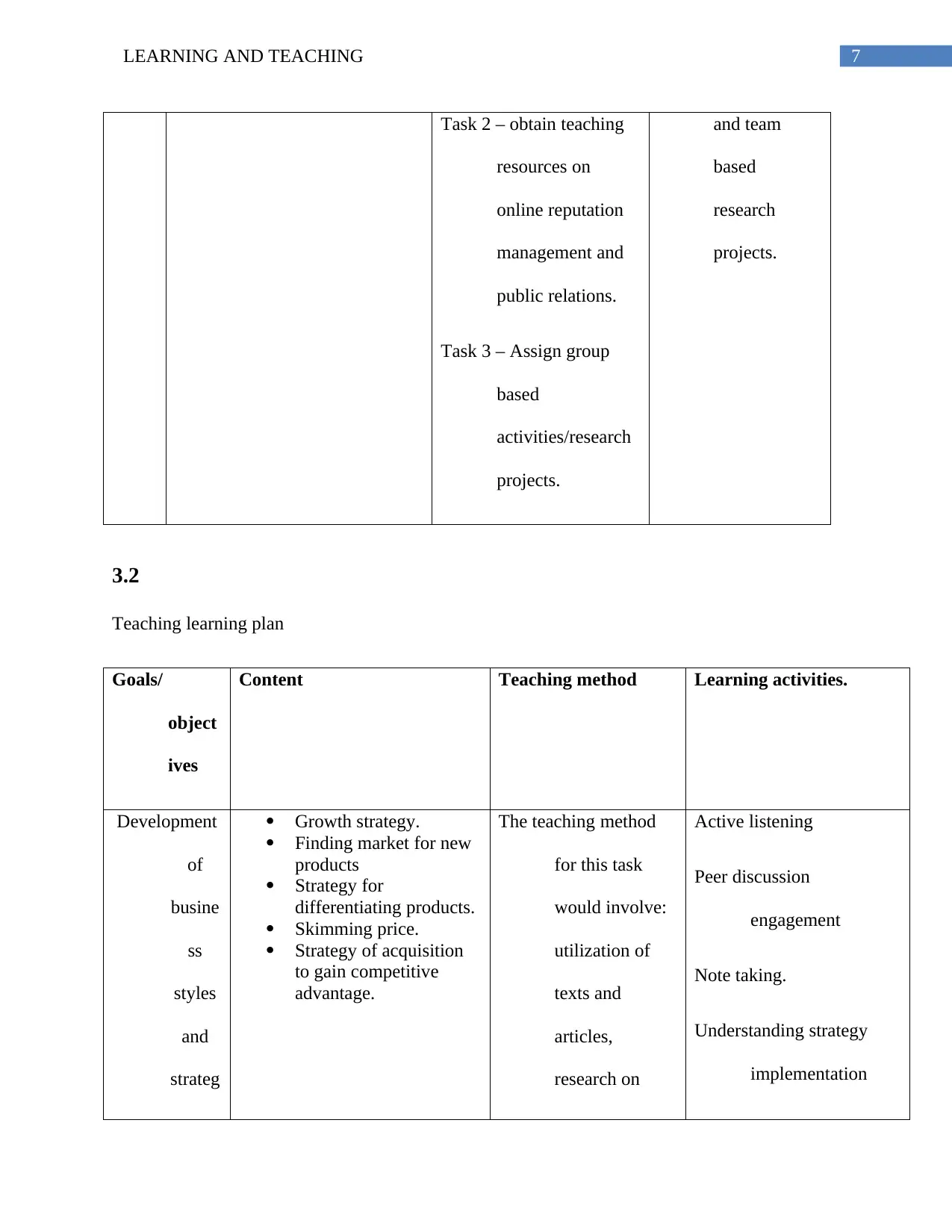
7LEARNING AND TEACHING
Task 2 – obtain teaching
resources on
online reputation
management and
public relations.
Task 3 – Assign group
based
activities/research
projects.
and team
based
research
projects.
3.2
Teaching learning plan
Goals/
object
ives
Content Teaching method Learning activities.
Development
of
busine
ss
styles
and
strateg
Growth strategy.
Finding market for new
products
Strategy for
differentiating products.
Skimming price.
Strategy of acquisition
to gain competitive
advantage.
The teaching method
for this task
would involve:
utilization of
texts and
articles,
research on
Active listening
Peer discussion
engagement
Note taking.
Understanding strategy
implementation
Task 2 – obtain teaching
resources on
online reputation
management and
public relations.
Task 3 – Assign group
based
activities/research
projects.
and team
based
research
projects.
3.2
Teaching learning plan
Goals/
object
ives
Content Teaching method Learning activities.
Development
of
busine
ss
styles
and
strateg
Growth strategy.
Finding market for new
products
Strategy for
differentiating products.
Skimming price.
Strategy of acquisition
to gain competitive
advantage.
The teaching method
for this task
would involve:
utilization of
texts and
articles,
research on
Active listening
Peer discussion
engagement
Note taking.
Understanding strategy
implementation
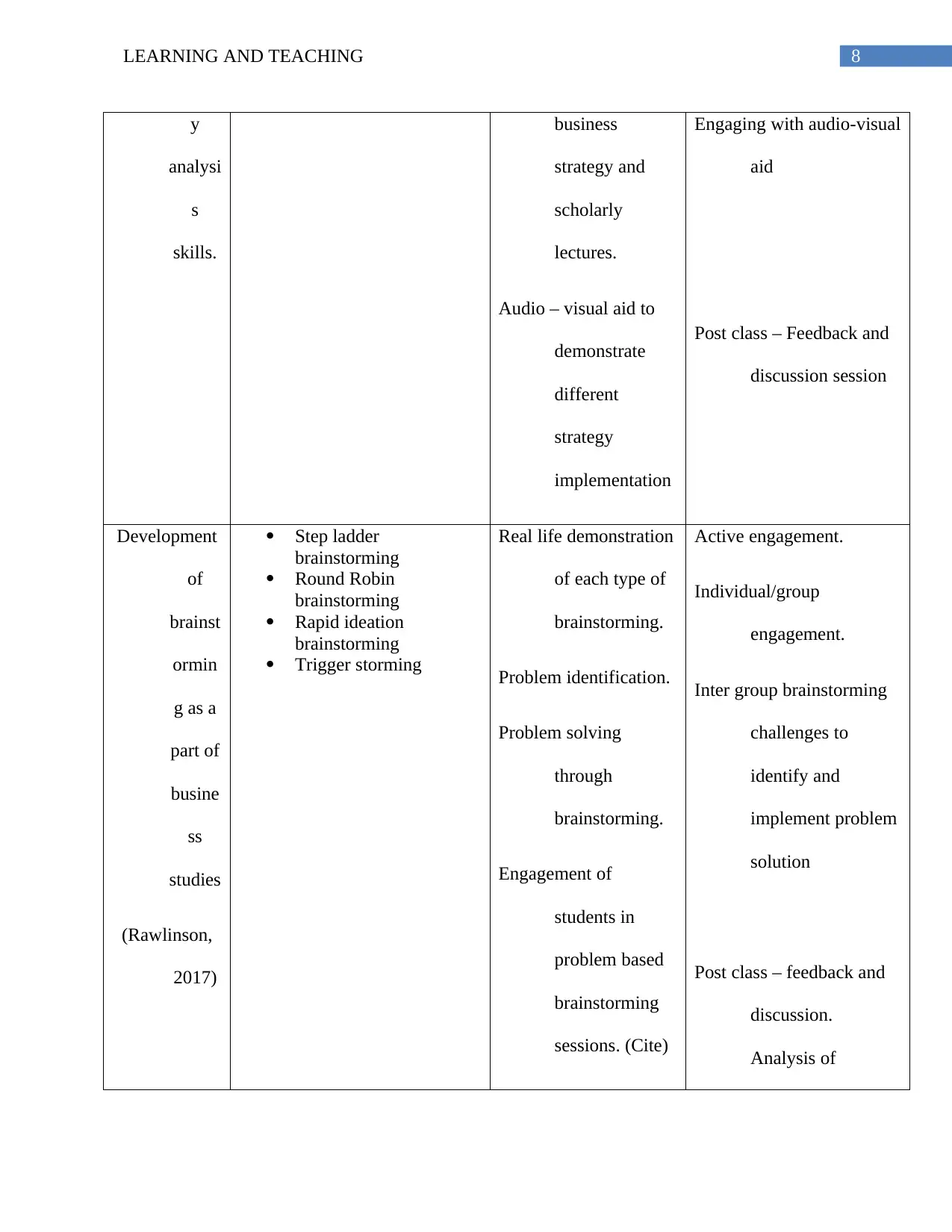
8LEARNING AND TEACHING
y
analysi
s
skills.
business
strategy and
scholarly
lectures.
Audio – visual aid to
demonstrate
different
strategy
implementation
Engaging with audio-visual
aid
Post class – Feedback and
discussion session
Development
of
brainst
ormin
g as a
part of
busine
ss
studies
(Rawlinson,
2017)
Step ladder
brainstorming
Round Robin
brainstorming
Rapid ideation
brainstorming
Trigger storming
Real life demonstration
of each type of
brainstorming.
Problem identification.
Problem solving
through
brainstorming.
Engagement of
students in
problem based
brainstorming
sessions. (Cite)
Active engagement.
Individual/group
engagement.
Inter group brainstorming
challenges to
identify and
implement problem
solution
Post class – feedback and
discussion.
Analysis of
y
analysi
s
skills.
business
strategy and
scholarly
lectures.
Audio – visual aid to
demonstrate
different
strategy
implementation
Engaging with audio-visual
aid
Post class – Feedback and
discussion session
Development
of
brainst
ormin
g as a
part of
busine
ss
studies
(Rawlinson,
2017)
Step ladder
brainstorming
Round Robin
brainstorming
Rapid ideation
brainstorming
Trigger storming
Real life demonstration
of each type of
brainstorming.
Problem identification.
Problem solving
through
brainstorming.
Engagement of
students in
problem based
brainstorming
sessions. (Cite)
Active engagement.
Individual/group
engagement.
Inter group brainstorming
challenges to
identify and
implement problem
solution
Post class – feedback and
discussion.
Analysis of
⊘ This is a preview!⊘
Do you want full access?
Subscribe today to unlock all pages.

Trusted by 1+ million students worldwide
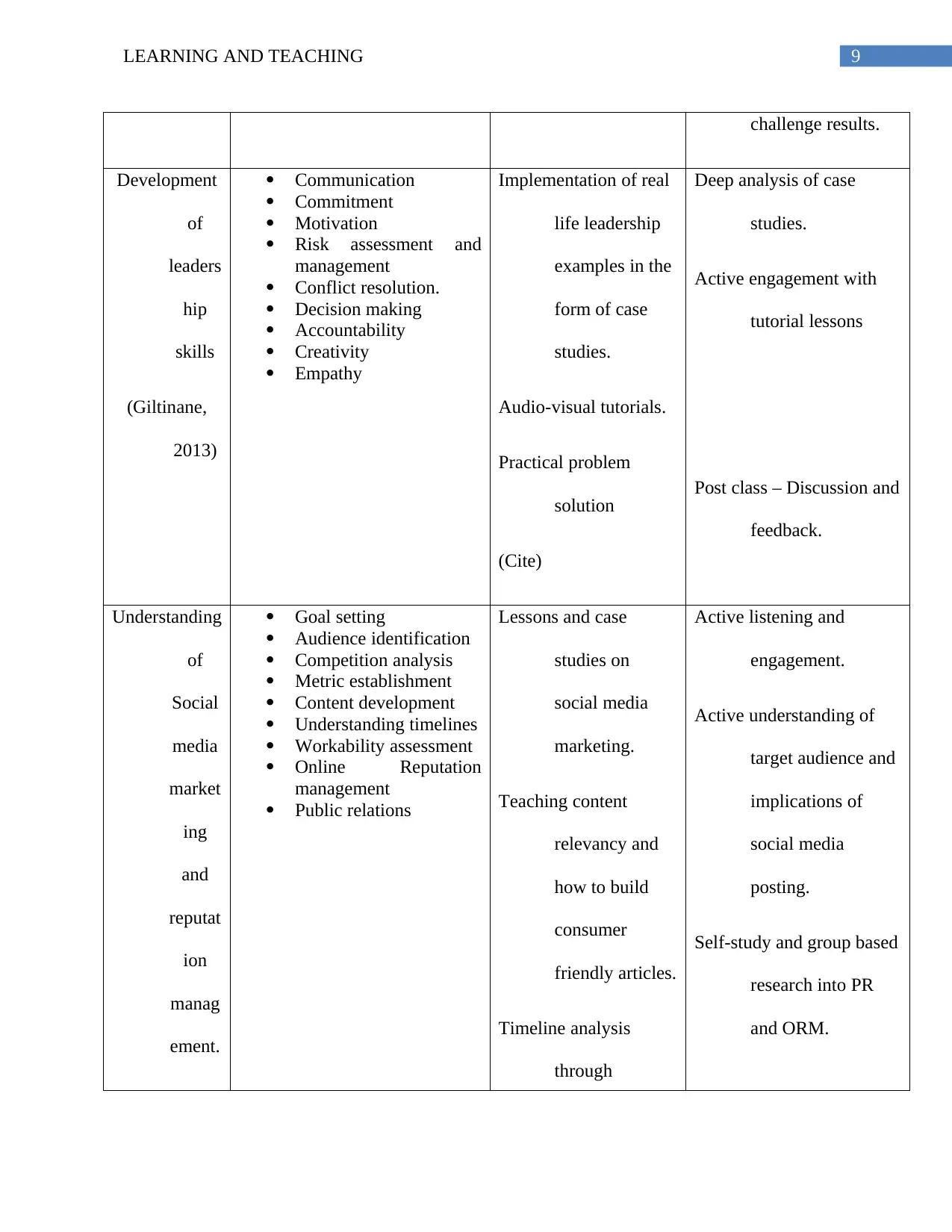
9LEARNING AND TEACHING
challenge results.
Development
of
leaders
hip
skills
(Giltinane,
2013)
Communication
Commitment
Motivation
Risk assessment and
management
Conflict resolution.
Decision making
Accountability
Creativity
Empathy
Implementation of real
life leadership
examples in the
form of case
studies.
Audio-visual tutorials.
Practical problem
solution
(Cite)
Deep analysis of case
studies.
Active engagement with
tutorial lessons
Post class – Discussion and
feedback.
Understanding
of
Social
media
market
ing
and
reputat
ion
manag
ement.
Goal setting
Audience identification
Competition analysis
Metric establishment
Content development
Understanding timelines
Workability assessment
Online Reputation
management
Public relations
Lessons and case
studies on
social media
marketing.
Teaching content
relevancy and
how to build
consumer
friendly articles.
Timeline analysis
through
Active listening and
engagement.
Active understanding of
target audience and
implications of
social media
posting.
Self-study and group based
research into PR
and ORM.
challenge results.
Development
of
leaders
hip
skills
(Giltinane,
2013)
Communication
Commitment
Motivation
Risk assessment and
management
Conflict resolution.
Decision making
Accountability
Creativity
Empathy
Implementation of real
life leadership
examples in the
form of case
studies.
Audio-visual tutorials.
Practical problem
solution
(Cite)
Deep analysis of case
studies.
Active engagement with
tutorial lessons
Post class – Discussion and
feedback.
Understanding
of
Social
media
market
ing
and
reputat
ion
manag
ement.
Goal setting
Audience identification
Competition analysis
Metric establishment
Content development
Understanding timelines
Workability assessment
Online Reputation
management
Public relations
Lessons and case
studies on
social media
marketing.
Teaching content
relevancy and
how to build
consumer
friendly articles.
Timeline analysis
through
Active listening and
engagement.
Active understanding of
target audience and
implications of
social media
posting.
Self-study and group based
research into PR
and ORM.
Paraphrase This Document
Need a fresh take? Get an instant paraphrase of this document with our AI Paraphraser
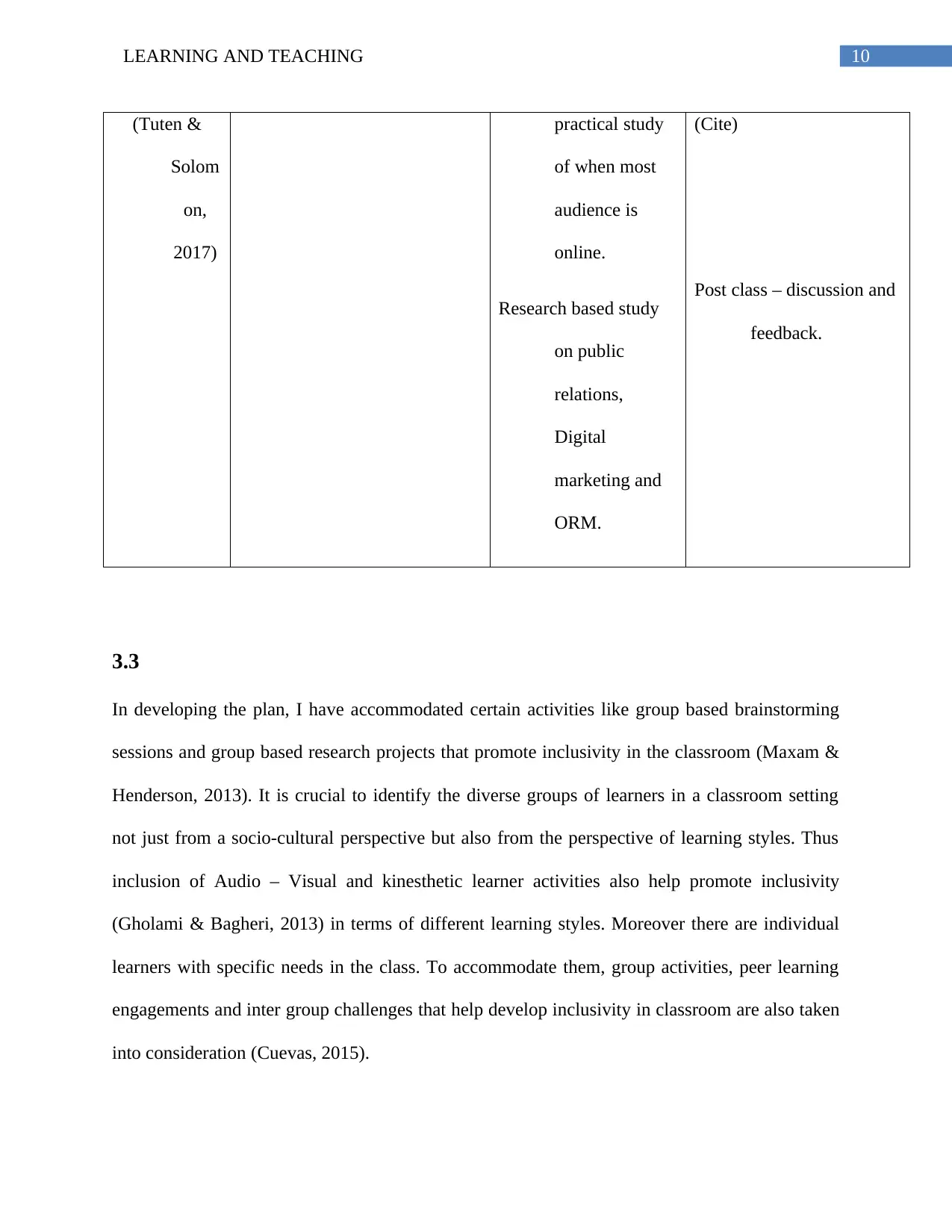
10LEARNING AND TEACHING
(Tuten &
Solom
on,
2017)
practical study
of when most
audience is
online.
Research based study
on public
relations,
Digital
marketing and
ORM.
(Cite)
Post class – discussion and
feedback.
3.3
In developing the plan, I have accommodated certain activities like group based brainstorming
sessions and group based research projects that promote inclusivity in the classroom (Maxam &
Henderson, 2013). It is crucial to identify the diverse groups of learners in a classroom setting
not just from a socio-cultural perspective but also from the perspective of learning styles. Thus
inclusion of Audio – Visual and kinesthetic learner activities also help promote inclusivity
(Gholami & Bagheri, 2013) in terms of different learning styles. Moreover there are individual
learners with specific needs in the class. To accommodate them, group activities, peer learning
engagements and inter group challenges that help develop inclusivity in classroom are also taken
into consideration (Cuevas, 2015).
(Tuten &
Solom
on,
2017)
practical study
of when most
audience is
online.
Research based study
on public
relations,
Digital
marketing and
ORM.
(Cite)
Post class – discussion and
feedback.
3.3
In developing the plan, I have accommodated certain activities like group based brainstorming
sessions and group based research projects that promote inclusivity in the classroom (Maxam &
Henderson, 2013). It is crucial to identify the diverse groups of learners in a classroom setting
not just from a socio-cultural perspective but also from the perspective of learning styles. Thus
inclusion of Audio – Visual and kinesthetic learner activities also help promote inclusivity
(Gholami & Bagheri, 2013) in terms of different learning styles. Moreover there are individual
learners with specific needs in the class. To accommodate them, group activities, peer learning
engagements and inter group challenges that help develop inclusivity in classroom are also taken
into consideration (Cuevas, 2015).

11LEARNING AND TEACHING
3.4
In the classroom, there are learners with the following differences that are identified.
Varied learning styles: Visual vs Auditory vs Kinesthetic
Social differences: communal, religious, cultural or ethnic differences.
Economic differences: belonging to low income families
Individual differences: varied levels of cognition and proficiency in subject matter, varied
ability to grasp concepts and implement in practical situations.
Identifying learners based on the above differences, the teaching plan has been devised to
promote inclusivity in classroom. For instance, the use of multimedia resources alongside text
materials ensure that the students with V-A-K based differences are accommodated (Cuevas,
2015). Similarly, the group based projects and challenges take care of the Socio-economic
differences by promoting connectivity among all. The pace of the lesson is developed to be
neither too fast or too slow, thereby accounting for the learners based on their individual
differences.
3.5
The best way to understand if inclusive practice has been implemented is through the feedback
provided by the students. The post class discussion and feedback sessions are developed with the
objective of gathering student feedback on every lesson. This would help indicate if an inclusive
practice has been implemented.
3.4
In the classroom, there are learners with the following differences that are identified.
Varied learning styles: Visual vs Auditory vs Kinesthetic
Social differences: communal, religious, cultural or ethnic differences.
Economic differences: belonging to low income families
Individual differences: varied levels of cognition and proficiency in subject matter, varied
ability to grasp concepts and implement in practical situations.
Identifying learners based on the above differences, the teaching plan has been devised to
promote inclusivity in classroom. For instance, the use of multimedia resources alongside text
materials ensure that the students with V-A-K based differences are accommodated (Cuevas,
2015). Similarly, the group based projects and challenges take care of the Socio-economic
differences by promoting connectivity among all. The pace of the lesson is developed to be
neither too fast or too slow, thereby accounting for the learners based on their individual
differences.
3.5
The best way to understand if inclusive practice has been implemented is through the feedback
provided by the students. The post class discussion and feedback sessions are developed with the
objective of gathering student feedback on every lesson. This would help indicate if an inclusive
practice has been implemented.
⊘ This is a preview!⊘
Do you want full access?
Subscribe today to unlock all pages.

Trusted by 1+ million students worldwide
1 out of 29
Related Documents
Your All-in-One AI-Powered Toolkit for Academic Success.
+13062052269
info@desklib.com
Available 24*7 on WhatsApp / Email
![[object Object]](/_next/static/media/star-bottom.7253800d.svg)
Unlock your academic potential
Copyright © 2020–2025 A2Z Services. All Rights Reserved. Developed and managed by ZUCOL.





